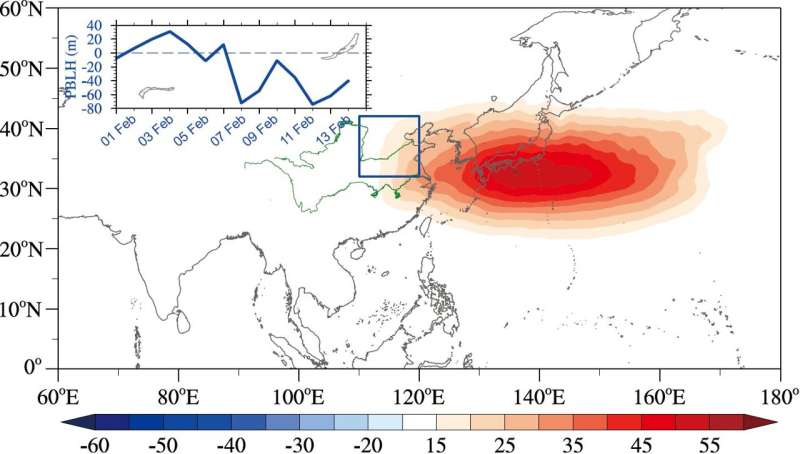This article has been reviewed according to Science X's editorial process and policies. Editors have highlighted the following attributes while ensuring the content's credibility:
fact-checked
peer-reviewed publication
trusted source
proofread
Does rainfall in southern China contribute to air pollution in the North China Plain?

The North China Plain (NCP) is a region with some of the worst air pollution conditions on a global scale. Air pollution (known as haze) dominated by higher PM2.5 concentration, is well-documented for its adverse impacts on both human health and socioeconomic progress.
Despite rigorous emissions reduction measures implemented by the Chinese government, the region continues to grapple with severe air pollution episodes virtually every year. For instance, in early February 2023, the average PM2.5 concentration over the North China Plain during this period ranked as the third-highest in the past nine years, accompanied by a yearly increase of 23.2% and a prolonged duration.
Dr. Xiadong An, affiliated with the College of Oceanic and Atmospheric Sciences at Ocean University of China, collaborated with Wen Chen, Professor of the School of Earth Science at Yunnan University, and Professors Chun Li and Lifang Sheng from Ocean University of China to conduct a comprehensive investigation into this substantial haze event. The team found that a strong quasi-barotropic anomalous anticyclone in the troposphere over the Pacific Northwest was responsible for the heavy haze.
This anomalous anticyclone, previously labeled the Northeast Asian Anomalous Anticyclone (NAAA) by Dr. Xiadong An and co-authors in prior studies, exhibits a propensity to decrease surface wind speeds, elevate relative humidity, raise air temperatures within the lower troposphere, and lower the atmospheric boundary layer height. These meteorological changes create favorable conditions for the emergence of severe haze.
To their astonishment, southern China witnessed its second most substantial rainfall in nine years during the same period. Dr. Xiadong An and Professor Chun Li, in collaboration with Professor Wen Chen, embarked on a quest to ascertain the potential correlation between rainfall in southern China and the occurrence of severe haze over the North China Plain.

Utilizing a state-of-the-art mesoscale Weather Research & Forecasting (WRF) model, the research team conducted numerical model experiments to scrutinize the influence of rainfall on the development of severe haze. The findings reveal that rainfall can trigger an anticyclonic anomaly over the Pacific Northwest through diabatic heating, consequently intensifying the magnitude of the anomalous anticyclone driven by background atmospheric circulations, with a substantial contribution of 27%.
As a result, the North China Plain becomes more susceptible to severe haze. For example, the atmospheric boundary layer height is notably reduced in the WRF model, favoring air pollution over the North China Plain.
Furthermore, the rainfall also contributes to itself through convective feedback (with a contribution of 11.5%). Of course, the effect of atmospheric circulation on the rainfall is also undeniable. These findings suggest that southern rainfall-northern haze tends to occur in eastern China, with the former playing a contributory role in the latter.
In the end, the researchers had to say that southern rainfall-north haze in eastern China is not an isolated incident, and it is probable to recur. Consequently, there is a pressing need to closely monitor the synchronized dynamics of rainfall and polluted weather.
This research offers a fresh perspective on understanding the impact of rainfall in southern China on haze over the North China Plain. Given the profound implications of air pollution on human health, any effort to investigate its underlying causes is laudable. While this study has shed light on the physical mechanisms linking rainfall in southern China to the development of severe haze over the North China Plain, it is still highly desirable to investigate it on a longer time scale and on a wider spatial scale in the future.
The findings are published in the journal Science China Earth Sciences.
More information: Xiadong An et al, Influence of rainfall-induced diabatic heating on southern rainfall-northern haze over eastern China in early February 2023, Science China Earth Sciences (2023). DOI: 10.1007/s11430-023-1181-3
Journal information: Science China Earth Sciences
Provided by Science China Press


















